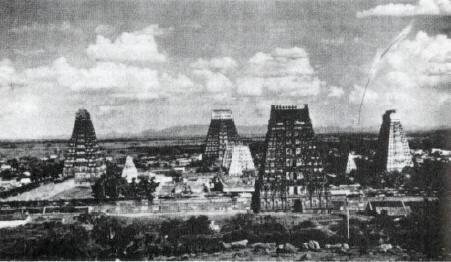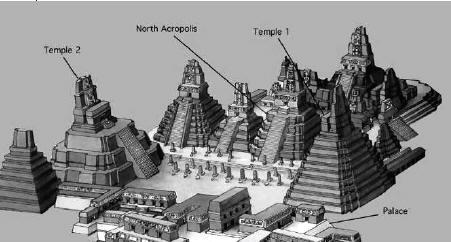Grid of the Gods (35 page)
Authors: Joseph P. Farrell,Scott D. de Hart

This part of the
Popol Vuh
begins by noting that at the beginning of the “conception of humans” there was a search for “the ingredients of the human body” by the “Bearer, Begetter, the Makers,
Modelers named Sovereign Plumed Serpent.”
14
It is interesting to note that one is dealing with Quetzlcoatl again, but note that this deity is spoken of both in singular and plural terms, rather like a “council of the gods.” This fashioning of mankind is called the making or modeling “of our first mother-father,”
15
and with that, we have encountered our first Mayan androgynous image for God Himself.
The
Popul Vuh
goes on to explain this androgyny in explicitly masculine terms: “They were good people, handsome, with looks of the male kind.”
16
Then follows one of the most bizarre passages in the entire book:
And then
they saw everything under the sky perfectly
. After that, they thanked the Maker, Modeler:
“ Truly now,
double thanks, triple thanks
that we’ve been formed, we’ve been given
our mouths, our faces,
we speak, we listen,
we wonder, we move,
our knowledge is good, we’ve understood
what is far and near,
and we’ve seen what is great and small
under the sky or on earth.
Thanks to you we’ve been formed,
we’ve come to be made and modeled,
our grandmother, our grandfather.”
they said when they gave thanks for having been made and modeled.
They understood everything perfectly, they sighted the four sides, the four corners in the sky, on the earth, and this didn’t sound good to the builder and sculptor:
“What our works and designs have said is no good:
“‘We have understood everything, great and small,’ they say.” And so the Bearer, Begetter took back their knowledge.
“What should we do with them now? Their vision should at least reach nearby, they should at least see a small part of the face of the earth, but what they’re saying isn’t good. Aren’t they merely
‘works’ and ‘designs’ in their very names? Yet
they’ll become as great as gods, unless they procreate, proliferate at the sowing, the dawning, unless they increase.”
“Let it be this way: now we’ll take them apart just a little
, that’s what we need. What we’ve found out isn’t good.
Their deeds would become equal to ours, just because their knowledge reaches so far.
They see everything,” so said
the Heart of Sky, Hurricane,
Newborn Thunderbolt, Sudden Thunderbolt, Sovereign Plumed Serpent,
Bearer, Begetter, Xiyacoc, Xmucane, Maker, Modeler
as they are called. And when they changed the nature of their works, their designs, it was enough that the eyes be marred by the Heart of Sky....
And such was the loss of the means of understanding, along with the means of knowing everything, by the four humans. The root was implanted....
And then their wives and women came into being.
17
This passage requires careful scrutiny and unpacking in order for the full weight of its implications to sink in.
1) Note first of all that, just as in the Biblical story of the Tower of Babel,
18
there is no notion of morality in play, for the activities of mankind are not perceived so much as
immoral
but rather as an
implicit threat
to the power of the gods “just because their knowledge reaches so far.” One is reminded of the biblical reason given for the confounding of languages at the Tower of Babel, for if the Tower was completed, mankind would be able “to do whatever it imagined to do;”
2) This human knowledge, in so far as the
Popol Vuh
is concerned, relates somehow to mankind’s cosmological knowledge, to his understanding of the
physics
of the cosmos and being able to sight “the four corners in the sky, on the earth.” Given thetopological metaphor we have examined
previously, the metaphor here seems to be suggesting thatmankind’s knowledge was of the very way the physical medium itself was constituted and of how it operated. This too is mirrored in the biblical Tower of Babel story, where the purpose of the Tower is to “reach unto heaven;”
19
again implying that somehow human knowledge was of a deep physics;
3) In the
Popol Vuh
, all this knowledge and deep insight is coupled somehow to what can only be described as mankind’s primordial “masculine homosexual-androgyny,” a fact that seems also to be reproduced in the way that this creature refers also to the Sovereign Plumed Serpent, or God, both as grandmother and grandfather, as an androgyny; God, in other words, is viewed in the same way and this, somehow, suggests that in mankind, in his primordial masculine homosexual-androgynous constitution, had knowledge of some characteristic of the physical medium that he would not otherwise have had; this leads to the next point:
4) The
Popol Vuh
makes it very clear that this primordial “masculine homosexual-androgyny” had to be divided “just a little” in order to eradicate the threat posed by the knowledge he possessed in that original state; the division of the sexes is accomplished, and at
this
point “their wives and women came into being,” causing procreation and the corresponding loss of human knowledge. This seems to imply that in mankind’s primordial state, immortality was the natural consequence, and therefore with it, a commensurately wide knowledge. It is worth noting that a vaguely similar idea is even suggested in the biblical account of the Tower of Babel moment, where it says “And the LORD said, Behold,
the people is one
.” Again, the solution is to divide humanity; in the biblical instance, it is division through multiplication of languages; in the Mayan instance, it is division by the division of the sexes;
5) And lest it be thought that this primordial view of mankind as a kind of “masculine homosexual-androgyny” is far removed from the world of the Old Testament half a world and
centuries away, a closer look at Gen 1:27 is in order. In the standard English translation the verse reads “So God created man in his own image, in the image of God created he him; make and female created he them.” But in the Septuagint Greek of the verse, the word “them” is actually
“them,”
but with one difference, the word “them” here is also masculine in gender, but lacks a second repetition of the word “them” in the feminine gender. Thus, while the verse can certainly be interpreted in the traditional manner with the masculine “them” as a
pars pro toto
usage designating a male and female “them,” it is also worth nothing that it is capable of bearing a Mayan-like interpretation as well, as indicating a kind of “primordial masculine homosexual-androgyny,” with the subsequent division of the sexes in Genesis chapter two representing a kind of “second creation;” this little-known possibility would in fact lead to many interesting speculations in the early centuries of Christianity, but this is not the place to delve into them.
20
As we turn from this suggestive passage and all the previous allusions to the topological metaphor in the
Popol Vuh
to a consideration of the actual structures of Meso-America themselves, bear in mind that deep knowledge and the implied deep physics, for now it begins to come home to roost; and with it, we also see the beginning glimmers of the reasons for the practice in these societies of human sacrifice.
B. The Structures
1. Tikal and Chichen Itza
We will begin this technical exposition at Tikal in CentralAmerica. The first thing to be noted about Tikal is that it lies exactly120 degrees longitude
west
of Giza, in other words, exactly one third the distance around the world from Giza. Here there are five large Mayan pyramids, which are unusual in that they are all
taller
than they are
wide.
In this, the Mayan Pyramids — like their mythology —
suggests connections to India, where similar temples are in evidence at Madurai:

The Madurai Temples in Southern India
There are five such elongated pyramids at Tikal, and like the temples of Maduari in India, they all have a temple-like structure at the top of the edifice:

Layout of Tikal
21
Munck gives the heights of these temples as follows:
1) Temple I: 154.8 feet;
2) Temple II: 142.7 feet;
3) Temple III: 177.8 feet;
4) Temple IV: 228.6 feet;
5) Temple V: 188 feet.
22
Additionally, each of these Temples incorporates some harmonic of the number 656, usually at the level of the platform on which the temple atop the structure rests.
23
Three of the temples — II, III, and IV — face east, temple V faces north, and temple I faces west, and again, the center of the compound is 120 degrees west of the Giza prime meridian. Moreover, each of these temples, with the exception of temple II, all have ten steps or terraces, with the temple atop the tenth. Temple II has three major terraces. But most importantly, all these temples are all, per Munck’s classification,
corrupted
pyramids, that is, they are stepped pyramids with
corners and faces
, and all of them are
higher
than the width of their
base.
For the moment, we will forego the counting of corners and faces on these monuments to comment on the second fact concerning these pyramids: that they are taller than their base.
It is this fact that leads us into the deep physics that these structures were possibly designed to access, for all pyramids have one property in common: they all have some relationship of base-to-height proportional to π divided by two, that is, the basic formula of all pyramids is:
 where h = height, b = base.
where h = height, b = base.
